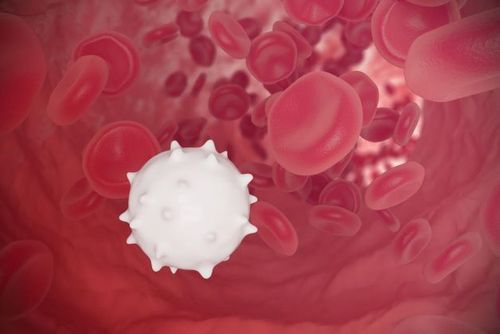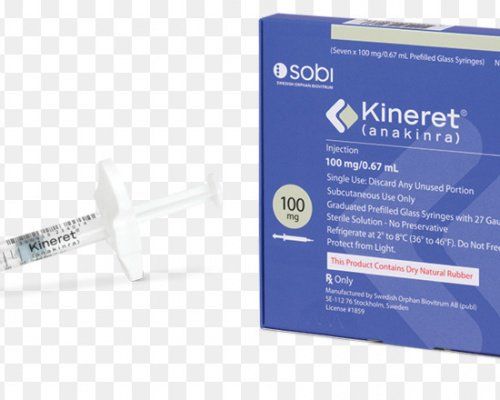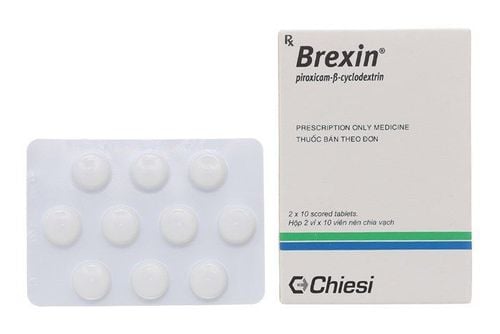This is an automatically translated article.
The active ingredient Datisoc is Methyl Prednisolone. This drug belongs to the group of corticosteroids. The drug is effective in the treatment of anti-inflammatory and anti-allergic effects.1. What is Datisoc?
Drug class: Drugs belonging to the group of Corticosteroids, endocrine drugs and anti-inflammatory drugs.
Dosage form: Tablet form.
Packing method: box of 5 blisters x 10 tablets.
Ingredients: Each tablet contains the main active ingredient Methyl prednisolone: 16.0 mg and other excipients in a sufficient amount.
1.1. Pharmacodynamics Anti-inflammatory effects:
Corticosteroids (also known as corticosteroids) act on many different stages of the inflammatory process, regardless of the cause of the inflammation. Anti-inflammatory mechanism of synthetic corticosteroids: inhibiting arachidonic acid production, thereby reducing the synthesis and release of inflammatory substances such as prostaglandins, leucotrienes... At the same time, the drug inhibits the production of mediators. of the inflammatory process, inhibiting vasodilation and increasing capillary permeability in the area of injury; inhibits leukocyte migration, reduces phagocytosis of macrophages, polymorphonuclear leukocytes, and reduces the production of cytokines. In addition, the active ingredient Methyl Prednisolone has a stabilizing effect on the mitochondrial membranes of polymorphonuclear leukocytes and macrophages. Thereby, the drug inhibits the release of proteolytic enzymes, superoxide ions (free radicals). Immunosuppressive effects:
Glucocorticoids mainly affect the cellular immune system through the mechanism of inhibiting the proliferation of T lymphocytes, reducing the cytotoxic activity of T lymphocytes and cells. Natural killers (NKs) are cells that play an important role in immunity. Methyl Prednisolone also inhibits the production of TNF, interferon, reduces bactericidal activity, cytotoxicity and antigen recognition of macrophages. Immunosuppressive effect is shown when used with high doses equivalent to 1-2 mg of Prednisolone/kg body weight/day. Anti-allergic effects:
Corticosteroid drugs, including the active ingredient Methyl Prednisolone, have strong anti-allergic effects. 1.2. Pharmacokinetics Absorption: Methylprednisolone acetate is hydrolyzed to the active form by serum cholinesterase enzymes. In humans, methylprednisolone forms weak complexes that readily separate with Albumin and Transcortin. Distribution: Approximately 40-90% of the drug Datisoc is bound to these substances. The intracellular action of the glucocorticoid group results in a clear difference between the plasma half-life and the pharmacological half-life. The duration of anti-inflammatory activity of Glucocorticoid drugs is similar to that of hypothalamic-pituitary-adrenal (HPA) axis reduction. Metabolism potential: hepatic metabolism of methylprednisolone to the major metabolites is 20-beta hydroxy methylprednisolone and 20-beta-hydroxy-6-alpha-methylprednisolone. Elimination: The metabolites are excreted mainly in the urine. These conjugation reactions occur mainly in the liver and to some extent in the kidneys. 1.3. Methylprednisolone is a Glucocorticoid, 6-alpha methyl derivative of Prednisolone, with obvious anti-inflammatory, anti-allergic and immunosuppressive effects. Due to prednisolone methylation, a salt-metabolizing corticosteroid effect was excluded. Therefore, the drug has very little risk of keeping Na+ and causing edema when using the drug. The anti-inflammatory effect of Methylprednisolone is increased by 20% compared to that of Prednisolone.
2. What disease does Datisoc treat?
Datisoc is indicated in non-specific therapy requiring the anti-inflammatory and immunosuppressive effects of glucocorticoids for:
Rheumatoid arthritis; Systemic lupus erythematosus ; Some forms of vasculitis such as temporal arteritis or nodular periarteritis; Sarcoid pathology; Asthma ; Chronic ulcerative colitis; Blood diseases such as anemia, hemolysis, leukopenia; Severe allergic conditions including anaphylaxis. Medicines containing the active ingredient Methyl prednisolone are also indicated in the treatment of primary nephrotic syndrome..
3. Usage and dosage of the drug Datisoc
3.1. How to use the drug Datisoc Datisoc drug is prepared in the form of tablets, suitable for oral use. When large therapeutic doses are required for a long time: should be used every other day, a single dose every 2 days in the morning. 3.2. Dosage of Datisoc The appropriate therapeutic dose may vary from person to person. In acute indications, the lowest therapeutic dose for the shortest duration should be used. Using a single therapeutic dose per day causes fewer side effects than split doses. Treatment of severe asthma attacks: daily, 32 - 48 mg (corresponding to 2 - 3 tablets). Then gradually reduce the therapeutic dose and may stop within 10 days to 2 weeks. Treatment of acute asthma: oral dose of 32-48mg/day (2-3 tablets/day), for 5 days, then additional treatment with lower therapeutic dose for 1 week, when from an acute attack reduce the dose gradually. Treatment of severe rheumatic diseases: initially use Datisoc with a therapeutic dose of 0.8mg/kg/day divided into several small doses, then use a single daily dose; gradually reduce the therapeutic dose to the minimum effective dose. Treatment of rheumatoid arthritis: starting at a dose of 4mg/day. In the acute phase, it is necessary to increase the therapeutic dose to 16-32 mg/day and then gradually reduce it. Severe acute exacerbation of chronic ulcerative colitis: dose 8-24mg/day. Primary nephrotic syndrome: start with a dose of 0.8-1.6mg/kg for 6 weeks, then gradually reduce the dose over 6-8 weeks. Immune hemolytic anemia: taking the drug for 3 days, 64mg per day; then gradually reduce the therapeutic dose for 6-8 weeks. Sarcoid disease: the treatment dose is 0.8mg/kg/day to reduce the severity of the disease; then maintained at a dose of 8mg/day.
4. In case of missed dose or overdose of Datisoc
In case of overdose:
Long-term use of Datisoc may experience some signs and symptoms of overdose including: Cushing's syndrome, muscle weakness and osteoporosis. Using too high a dose of Datisoc for a long time leads to adrenal suppression and hyperadrenocorticism. How to handle overdose cases:
General management of Datisoc overdose is to reduce the therapeutic dose slowly. However, it is necessary to consult a treating doctor for a specific and appropriate treatment. Absolutely do not arbitrarily stop treatment with Datisoc drug suddenly.
5. Undesirable effects of the drug Datisoc
Please inform the treating doctor of the unwanted effects encountered after taking Datisoc medicine so that the dose can be adjusted in time.
Undesirable effects are most common when using the drug in high doses and for a long time.
Common undesirable effects when taking the drug are as follows:
Nervous system: insomnia or excitability. Digestive system: increased appetite, indigestion. Skin-hair: hirsutism. Metabolic: metabolic disorders, diabetes mellitus, joint pain. Eyes: cataracts, glaucoma. Epistaxis. Undesirable effects are rare. Nervous system: dizziness, psychosis, brain pseudotumor, headache, convulsions, mood swings, delirium, hallucinations or increased euphoria. Cardiovascular system: sodium and water retention, edema or hypertension. Skin: acne, skin atrophy. Cushing's syndrome. Inhibition of the pituitary-adrenal axis, growth retardation, glucose intolerance, hypokalemia, alkalosis, increased blood sugar. Digestive system: peptic ulcer, nausea, abdominal distension, esophagitis or pancreatitis. Musculoskeletal system: muscle weakness, osteoporosis or fracture. Hypersensitivity reactions.
6. Management of drug side effects
In acute indications, drugs containing methylprednisolone should be used at the lowest therapeutic dose and for the shortest duration of clinical effect. Prophylaxis of gastric and duodenal ulcers with H2-histamine antagonists when high doses of systemic methylprednisolone are used. All persons on long-term treatment with methylprednisolone require calcium supplementation to prevent osteoporosis. Persons potentially immunosuppressed by methylprednisolone should be warned about the potential for infection. Patients undergoing surgery may need to take additional medications containing the active ingredient methylprednisolone because the normal response to stress has been impaired by inhibition of the hypothalamic-pituitary-adrenal axis.
7. Drug interactions of Datisoc
Datisoc drug induces cytochrome P450 enzymes, so it affects the metabolism of Cyclosporine, Erythromycin, Phenobarbital, Phenytoin, Carbamazepine, Ketoconazole and Rifampicin. Thereby, reducing the effect or causing an overdose of these concomitant drugs. Phenytoin, Phenobarbital, Rifampicin and other hypokalemic diuretics reduce the potency of Datisoc. Methyl prednisolone may increase blood sugar levels. As a result, people with diabetes may need higher therapeutic doses of insulin.
8. Some notes when using the drug Datisoc
8.1. Contraindications of the drug Datisoc: People with a history of hypersensitivity or hypersensitivity to any of the ingredients of the drug.
People with severe infections, except in cases of septic shock or tuberculous meningitis. Lesions on the skin caused by viruses, fungi or tuberculosis. People who are using live attenuated vaccines. 8.2. Notes and cautions when using Datisoc This is a drug sold with a doctor's prescription. Do not arbitrarily buy and use Datisoc medicine without the examination and advice of a doctor. Datisoc should be used with caution in people with osteoporosis, people with new vascular connections, mental disorders, peptic ulcers, heart failure, diabetes, hypertension, children going through puberty, the elderly. , pregnant. Caution should be exercised when stopping treatment with Datisoc suddenly after a long period of treatment or after stress because it may cause adrenal insufficiency. When using high doses of Datisoc drug can affect the effectiveness of vaccination. It is necessary to prevent unwanted effects: gastric ulcer - duodenal (with Histamine H2 receptor antagonists); osteoporosis when using Glucocorticoid long-term (with calcium-containing preparations). 8.3. Use Datasoc for special objects. Using the drug with infants: There is currently no specific information as well as safety and effectiveness when using Datisoc in infants. You should consult your doctor and weigh the benefits and risks with your child before giving it to your child. Using drugs with pregnant women: Using drugs of Datisoc or systemic corticosteroids for a long time may slightly reduce the weight of the newborn. Breast-feeding women: There are currently no contraindications to using Datisoc for this population. Using drugs with drivers: Some undesirable effects of Datisoc were recorded with common frequency such as insomnia and irritability. Therefore, do not use this product during activities requiring alertness such as driving and operating machinery. Above is information about Datisoc drug, patients need to carefully read the instructions for use, consult a doctor before using. When the drug is no longer in use, you need to collect and dispose of it according to the manufacturer's instructions.
Please dial HOTLINE for more information or register for an appointment HERE. Download MyVinmec app to make appointments faster and to manage your bookings easily.













